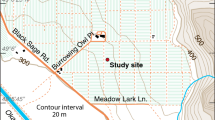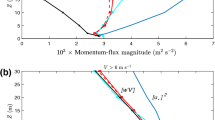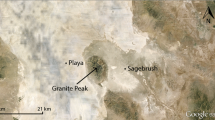Abstract
The formation of cold air drainage flows in a shallow gully is studied during CASES-99 (Cooperative Atmosphere-Surface Exchange Study). Fast and slow response wind and temperature measurements were obtained on an instrumented 10-m tower located in the gully and from a network of thermistors and two-dimensional sonic anemometers, situated across the gully. Gully flow formed on clear nights even with significant synoptic flow. Large variations in surface temperature developed within an hour after sunset and in situ cooling was the dominant factor in wind sheltered locations. The depth of the drainage flow and the height of the down-gully wind speed maximum were found to be largest when the external wind speed above the gully flow is less than 2 m s-1. The shallow drainage current is restricted to a depth of a few metres, and is deepest when the stratification is stronger and the external flow is weaker. During the night the drainage flow breaks down, sometimes on several occasions, due to intermittent turbulence and downward fluxes of heat and momentum. The near surface temperature may increase by 6 ° C in less than 30 min due to the vertical convergence of downward heat flux. The mixing events are related to acceleration of the flow above the gully flow and decreased Richardson number. These warming events also lead to warming of the near surface soil and reduction of the upward soil heat flux. To examine the relative importance of different physical mechanisms that could contribute to the rapid warming, and to characterize the turbulence generated during the intermittent turbulent periods, the sensible heat budget is analyzed and the behaviour of different turbulent parameters is discussed.
Similar content being viewed by others
References
Blumen, W.: 1984, 'An Obsevational Study of Instability and Turbulence in Nightime Drainage Winds', Boundary-Layer Meteorol. 28, 245–269.
Blumen, W., Grossman, R. L., and Piper, M.: 1999, 'Analysis of Heat Dissipation and Frontogenesis in a Shallow Density Current', Boundary-Layer Meteorol. 91, 281–306.
Brost, R. A. and Wyngaard, J. C.: 1978: 'A Model Study of the Stably Stratified Planetary Boundary Layer', J. Atmos. Sci. 35, 1427–1440.
Daubechies, I.: 1992, Ten Lectures on Wavelets, Society for Industrial and Applied Mathematics, Capital City Press, Philadelphia, 356 pp.
Högström, U.: 1988, 'Non-Dimensional Wind and Temperature Profiles in the Atmospheric Surface Layer: A Re-Evaluation', Boundary-Layer Meteorol. 42, 55–78.
Horst, T. W. and Doran, J. C.: 1986, 'Nocturnal Drainage Flow on Simple Slopes', Boundary-Layer Meteorol. 34, 263–286.
Kaimal, J. C.: 1973, 'Turbulence Spectra, Length Scales and Structure Parameters in the Stable Surface Layer', Boundary-Layer Meteorol. 4, 289–309.
Kaimal, J. C. and Finnigan, J. J.: 1994, Atmospheric Boundary Layer Flows, Oxford University Press, 289 pp.
Kiehl, J.: 1996, Description of the NCAR Community Climate Model (CCM3), Technical Note, NCAR/TN-420, NCAR, P.O. Box 3000, Boulder, CO, 80307, U.S.A.
Mahrt, L.: 1982, 'Small Scale Drainage Front', Tellus 4, 579–587.
Mahrt, L. and Gamage, N.: 1987, 'Observations of Turbulence in Stratified Flow', J. Atmos. Sci. 44, 1106–1121.
Mahrt, L. and Vickers, D.: 2002, 'Contrasting Vertical Structures of Nocturnal Boundary Layers', Boundary-Layer Meteorol.105, 351–363.
Mahrt, L., Vickers, D., Nakamura, R., Soler, M. R., Sun, J., Burns, S., and Lenschow D. H.: 2001, 'Shallow Drainage Flows', Boundary-Layer Meteorol. 101, 243–260.
Nieuwstadt, F. T. M.: 1984, 'The Turbulent Structure of the Stable, Nocturnal Boundary Layer', J. Atmos. Sci. 41, 2202–2216.
Papadoulos, K. H. and Helmis, C. G.: 1999, 'Evening and Morning Transition of Katabatic Flow', Boundary-Layer Meteorol.92, 195–227.
Poulos, G. S., Blumen, W., Fritts, D. C., Lundquist, J. K., Sun, J., Burns, S. P., Nappo, C., Banta, R., Newsom, R., Cuxart, J., Terradellas, E., Balsley, B., Jensen, M.: 2002, 'CASES-99: A comprehensive Investigation of the Stable Nocturnal Boundary Layer', Bull. Amer. Meteorol. Soc. 83, 555–581.
Rees, J. M.: 1991, 'On the Characteristics of Eddies in the Stable Atmospheric Boundary Layer', Boundary-Layer Meteorol.55, 325–343.
Stull, R. B.: 1988, An Introduction to Boundary Layer Meteorology, Kluwer Academic Publishers, Dordrecht, 666 pp.
Van der Avoid, E. and Duynkerke, P.: 1999, 'Turbulence in a Katabatic Flow', Boundary-Layer Meteorol. 92, 39–66.
Vickers, D. and Mahrt, L.: 1997, 'Quality Control and Flux Sampling for Tower and Aircraft Data', J. Atmos. Oceanic Tech.14, 512–526.
Vickers, D. and Mahrt, L.: 2001, 'CASES99 Tower Data’ (http: moppet. oce. orst. edu/Software/QC-v2).
Author information
Authors and Affiliations
Rights and permissions
About this article
Cite this article
Soler, M., Infante, C., Buenestado, P. et al. Observations Of Nocturnal Drainage Flow In A Shallow Gully. Boundary-Layer Meteorology 105, 253–273 (2002). https://doi.org/10.1023/A:1019910622806
Issue Date:
DOI: https://doi.org/10.1023/A:1019910622806




